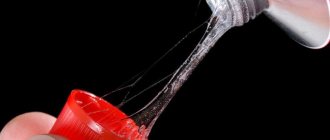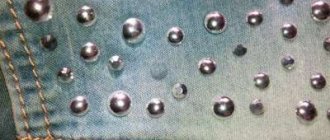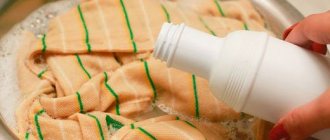Glass wool, how to wash it off the skin of your hands?
- The surest and most proven way to get rid of glass wool on the body is to heat your own bathhouse and steam in it, a true and proven method. A birch broom will simply drive all splinters out of the body. How many times have we dealt with this glass wool, but it is impossible to completely protect ourselves from it; it will still penetrate the body. Therefore, feel free to go to the bathhouse and steam yourself! Good luck to you.
When working with glass wool, you must wear special gloves, since glass wool is made from finely ground glass and is very dangerous not only for your hands but also for the whole body, since it does not stay on the skin but gets stuck into it, so you can wash off the residue with running water but do not rub your hands together for a few minutes, apply hand cream and consult a doctor.
Glass wool is an unpleasant phenomenon, I know it myself, next time try to work with gloves and protective equipment, I always wear 2 pairs of protective gloves, that’s for sure. If it happens that glass wool particles and crystals get in, then you can wash it off by washing your hands with ordinary laundry soap, you can also sprinkle a little quot;cometsquot; cleaning powder. or quot; mythquot; Yes, any, a little will do, then take any foam sponge, and rub your palm in a circular motion for about five minutes, but not too much, and that’s it. After doing this procedure 2-3 times, your hands will be free of glass wool fibers! This method has helped me more than once, both against glass wool and against, machine oil and more, fuel oil, etc. Good luck.
When working with glass wool, it is of course best to use protective clothing...
But if you get it on your skin, the first thing you CAN’T do is wash with hot water….
Only cold water, shower, also cold...
So be patient, there is no other way than cold water…….
I would advise you to use ordinary plasticine, just roll it in your hands, then take another piece (clean) and mash it in your hands again (do this several times. Then wash your hands with a scrub, lubricate it with cream, it should help.
If it itches very badly, you can try rolling Velcro or, in extreme cases, plasticine in your hands. These materials will take over at least a little of the glass, although not all of it. I stopped working with glass-containing materials a long time ago; I use gentle ones, like Knauf slabs, at least they don’t make you itch and don’t clog your lungs.
It is better to wear gloves when working with glass wool. But if you had to work without gloves, you should wash your hands with either laundry soap or dishwashing detergent; you can also butter your hands and wash them with dishwashing detergent.
The best way to protect yourself from glass wool is to not mess with it at all! If it were up to me, I would categorically prohibit this material, because... People’s health is more expensive and there are alternative methods of insulation. But in our country, for some reason, every boss considers people consumables, they don’t care about our health, the main thing is to save money for their own benefit. Dear Colleagues! I not only ask, but urge you - please refuse ANY work that is harmful to your health!!! You have every right to do this!!! Yes, I know that “this work cannot be postponed” always happens. And you have to choose either health, or a bonus, salary or even loss of job... Believe me, after receiving serious harm at work, you will think completely differently...
The first rule when glass wool gets on your body: do not scratch it.
!
The second rule: do not go to bed without washing after getting glass wool. Otherwise, your whole body will itch later.
To wash it off, you need to rinse with water. Hand washing clothes helps a lot. By rubbing your clothes, you remove pieces of fiberglass from the skin of your palms and arms, and you get immediate relief.
You can also anoint the affected areas with foam after shaving - it relieves annoying itching.
Be sure to shower with laundry soap.
And don't touch your eyes!
The task is not easy. You can try this method. While washing your hands, change the water temperature sharply. At the same time, the pores of the skin on the hands will either increase or decrease. Then wash your hands with soap and apply hand cream.
In the section on the question Glass wool. How to get rid of glass wool on clothes. assigned by the author Neuropathologist
the best answer is
to throw out the clothes)
Answer from 22 replies
[guru]
Hello! Here is a selection of topics with answers to your question: Glass wool. How to get rid of glass wool on clothes.
Reply from Space
[newbie] Rinse thoroughly in a bathtub full of water (not in a basin). Time 5. Between draining the old water and adding new water, rinse the clothes with a more powerful stream (adjustable nozzles allow you to do this) from the shower.
Answer from Oksana Lebedeva
[guru] If it’s wool, then, unfortunately, just throw it away (burn it). If it’s different, I’d try vacuuming. But these tiny needles are so corrosive and there are so many of them that I think it will be difficult. I found myself in a similar situation. Was washed with a powerful stream of water. You can try combining both a vacuum cleaner and rinsing in water without friction (that is, do not rub, but simply rinse with a stream of water), then dry and vacuum again.
Reply from skinny
[guru] To work with glass wool, clothes made of non-woven material are used. It costs 200 rubles on the market. It's disposable.
Reply from Poli
[guru] JUST THROW IT OUT - NO WAY and don’t even try
Reply from Heinrich Mont
[guru] I would try to wash it.
Reply from Misha
[expert] burn, the best
Reply from Genius Child
[guru] Burn clothes.
Reply from Bes Limit
[guru] Glass wool is one of the most popular insulation materials for the home. And since a significant part of Russians are engaged in the construction and insulation of houses on their own, many people use glass wool. They use it so much that it makes them itch. Because they don’t know how to behave correctly if glass wool gets on the skin. So, if glass wool gets on the skin, under no circumstances should you scratch the skin, because this will cause glass needles to rub into the skin. First, try to shake the glass wool out of your hair by shaking your head or gently brushing it away with your hands. Then you need to take a cold shower with maximum water pressure. Soap or shower gel, as well as a washcloth, cannot be used. After a shower, do not use a towel to dry yourself, but wait until your body is dry and take a shower again. Now you can use both gel and a washcloth for washing. After your shower, dry yourself with a towel. To remove glass wool from your clothes, you need to wash them. Washing is carried out separately from all other clothes, wearing gloves and using laundry soap. To get rid of glass wool, washing will need to be repeated 2-3 times. If glass wool gets into your eyes, do not immediately try to wash them out. You can rinse only after half an hour, and before that time you need to blink hard to remove the glass from your eyes. In general, to avoid such situations, you must not forget about the safety rules when working with glass wool - work in special clothing or at least in safety glasses, a respirator and clothing that completely covers the entire body.
- Main characteristics
Various types of insulation materials are used in the construction industry. They have their own characteristics, characteristics and installation technology. Among them, new generation building insulation materials are gaining the most popularity. These include expanded polystyrene, mineral wool and penoplex. The well-known glass wool does not give up its position and is successfully used in the construction of industrial premises and residential buildings.
Glass wool is used in various types of house construction, does not require special skills for installation and has excellent thermal insulation and sound insulation qualities. It is a universal insulation material and has high strength, elasticity and resistance to vibration. Glass wool is necessary for external and internal work, when installing pitched roofs and insulating horizontal surfaces. It can be used to seal gaps and cracks in walls. Glass wool is available in different forms - rolls or slabs. Many experts successfully use the material in practice, but do not even take into account the harmful properties of glass wool.
How to remove glass wool from clothes and skin, how to treat your hands
Due to the presence of glass fibers in glass wool, removing its components from clothing and skin is difficult. The material is very irritating to the skin and causes itching. It is necessary to work with it only in special clothing. Various methods are used to remove glass wool from the body and clothing.
Recommendations for cleaning the skin from this type of mineral wool
Do not rub the area where fragments of material have fallen. If its particles settle on your hands, then it is enough to shake them off or blow them off with a strong stream of air.
When working with the material you need to use glasses. If glass fibers get into your eyes, you should start blinking frequently. This will facilitate the rapid removal of fiberglass particles from them. Do not immediately rinse your eyes with water. This will make the situation worse.
You can wash your eyes only 30-35 minutes after fiberglass particles get into them. This must be done carefully. Don't rub your eyes too much. They need to be washed with plenty of cool water.
If the procedure does not help, you should contact an eye surgeon.
If glass wool fragments get into your eyes, you should immediately start blinking rapidly.
When working with the material, it is important to use a hat. If glass wool gets on your scalp, you need to shake your hair with your hands. This should be done with gloves. Your head should be bowed low over the bathtub. Eyes must be closed. Fibers can become trapped and cause irritation.
Below is a step-by-step method on how to remove glass wool from your skin. Necessary:
- Take a non-hot shower immediately. The water pressure should be maximum. Do not rub your skin with a washcloth. Do not use soap.
- Take a shower again. The water in it should not be hot. When washing, you can already use soap and a washcloth.
Allow the body to dry. Do not dry your body with a towel after showering.
Important! Do not wash in hot water. The shower should be cool. Hot water causes skin pores to expand. Microparticles of fiberglass may get caught in them, which will increase irritation.
If your body itches after taking a shower, it is recommended to apply a towel soaked in cold water to the exposed areas. You need to keep it on the skin for several minutes. If irritation does not go away, it is necessary to use emollients. You can moisten the skin with aloe juice or calendula solution.
You can eliminate irritation from glass fibers getting on your skin using aloe juice.
There are ways of what to do if your hands itch after removing glass wool from them. You can put a towel soaked in milk on them. It is recommended to use a softening hand cream. You can also apply shaving foam to the skin of your hands.
Ordinary plasticine will soften the itching on your hands. You need to knead it thoroughly. After this, you need to scrub your hands and anoint them with cortisone cream.
Important! You can lubricate the damaged skin with vegetable oil, wait a couple of minutes and rinse it off with warm water. Finally, treat the damaged area with peroxide.
Recommendations for cleaning fiberglass particles from clothing
It is necessary to work only in special clothing. If the material gets on ordinary things, you need to quickly remove it from them. Below is a method on how to remove glass wool from clothing. Necessary:
- Vacuum all items.
- Wash them by hand. Clothes must be washed separately from other items and only with gloves. Do not rub the laundry during washing. Simply rinse it thoroughly by placing it under a strong stream of cold water.
- Dry clothes thoroughly.
- Vacuum things again.
Remove fiberglass residue from clothing by rinsing it under a strong stream of cold water.
Do not immediately wet laundry that has been exposed to glass fibers. They penetrate deeper into wet fabric, after which it will be difficult to remove them from clothing. It is recommended to blow off fragments of material from things with a vacuum cleaner running at full power. Additionally, you can go over things with an antistatic roller.
A roller can be used to remove fiberglass from items.
Do not machine wash clothes containing fiberglass particles. Suitable for hand washing only. It is recommended to repeat this up to four times. If washing at home does not solve the problem, then you need to take the items to the dry cleaner. It is important to inform employees in advance that there are fiberglass fragments left in the clothing.
You should not work with the material in woolen items. In the future, it will be difficult to clean them from glass wool. You should not attempt to remove mineral wool fragments from clothing if it is heavily contaminated with them. Even repeated washing will not remove the glass fibers from it. It is recommended to throw away such clothes and buy new ones.
What you need to pay attention to when choosing workwear for a builder
If finishing work involves the use of glass wool, then you should choose the right workwear for it. She must be:
- dense;
- continuous (do not have any open areas);
- made from dirt-repellent materials (for quick cleaning of fiberglass);
- wear-resistant.
It is necessary to give preference to overalls in the form of a suit. The jumpsuit has open areas in the neck and arms. During operation, glass fibers may get caught on them and cause irritation.
As an alternative to thick fabric for workwear, it is allowed to use laminated fabric. It is also suitable for working with glass wool. The following items should be included with the overalls:
- gloves made of polymer fabric;
- respiratory shield;
- glasses.
When working with glass wool, the builder must be equipped with a suit made of thick fabric and protective equipment (goggles, respirator, gloves)
Overalls must be resistant to cutting damage. It should not be deformed after washing. You should choose workwear made from polymer fabrics. A product made from cheap synthetics has low protective properties. It wears out quickly. Overalls must be fire resistant.
To work with glass wool, it is recommended to purchase a product that does not have open pockets. Dust and other particles often accumulate in them. Workwear must be accompanied by durable shoes with thick soles. You must select the product by size. The item should not restrict movement. You should purchase moisture-resistant workwear.
What not to do with a resin trace
Before choosing how to remove tree sap from clothes, you should consider some important factors, otherwise you may accidentally damage the item irrevocably.
Before using one of the suggested cleaning methods, you need to scrape off the resin itself. All the proposed options are aimed at getting rid of its traces, but none of them will help get rid of it completely, without preliminary cleaning.
Brightly colored items made from delicate materials should not be cleaned with alcohol or any acids, because they can discolor the fabric at the point of contact. Vinegar, even diluted with water, should not be used on silk fabric. Strong alkaline solvents and especially bleaches are safe to use only for white things, otherwise the color will begin to peel off. Turpentine or gasoline are only suitable for rough fabrics
It is rational to use them for jackets, trousers and other things that do not require careful handling. They are also most suitable for hiking clothing, which is made from durable materials - gentle products may be ineffective. To prevent the stain from spreading further during the cleaning process, you can moisten the cloth around it with plain water or sprinkle it with starch/talcum powder. The directions of movements when cleaning should be from the edge to the center, and not vice versa, otherwise the dirt will spread and be firmly absorbed. It is advisable to clean from the inside out and move to the front side.
Before doing this, make sure that the fabric is not discolored. It is not advisable to leave the product on for longer than the recommended time, otherwise it may begin to corrode the fabric.
Since resin can be dissolved using different methods, the item stained with it will not be damaged forever
It is only important to know which methods are suitable for a particular material, as well as to have the necessary tools at hand. Even for delicate fabrics there are safe options with which the item will return to its normal state
In any case, you shouldn’t worry and throw away the item if there is a chance to save it. There are many ways to get rid of tar stains, and one of them will definitely help.
Health effects
All products of this company are made exclusively from safe and environmentally friendly materials. This is confirmed by both environmental and hygienic certificates. The document on environmental friendliness indicates research conducted in. Tests were also carried out by the Scientific Center for Children's Health. In both the first and second cases, it was proven that Isover products do not pose a threat to the health and life of an adult or a child.
The hygiene certificate states that all studies were carried out on the basis of current sanitary and epidemiological rules and regulations. As a result, experts concluded that Isover insulation products fully comply with standards and regulations and do not pose a danger to human health.
Moreover, insulation containing basalt boasts a high degree of fire resistance. Not all products have such characteristics. The remaining products simply belong to the group of non-combustible materials.
Isover thermal insulation is deservedly popular in the European and World markets. In addition to high environmental characteristics, these products have high levels of sound and heat insulation.
*information is posted for informational purposes; to thank us, share the link to the page with your friends. You can send material interesting to our readers. We will be happy to answer all your questions and suggestions, as well as hear criticism and suggestions at
Glass wool is a very effective thermal insulation material (a type of mineral wool), the production of which uses waste from the glass industry. Almost every boy knows that if you touch this material with an open part of the body, itching and rash are inevitable, as if from nettles.
Glass wool must be handled very carefully as it can cause an allergic reaction. When working with it, there is a whole set of safety rules that make it possible to eliminate undesirable consequences.
Glass wool is supplied in rolls. In some cases, its layers need to be cut (in accordance with the parameters of the surface that is being insulated). A sharp knife is used for this. The size of the cut mats should exceed the previously measured values by several centimeters. This will create the necessary density of the material and will not affect the thermal protection performance at all.
When working with glass wool, you must wear a dust blower, gloves and safety glasses. In addition, it is advisable to have clothing that can cover all parts of the body (tight overalls). As soon as the work with glass wool has been completed, it is important to carry out a thorough wet cleaning of the room. The result of all manipulations should be a shower.
Upon direct contact with glass wool, the first signs of irritation appear on the skin, itching, redness and other unpleasant sensations are observed. The safety measures indicated above can protect the human body from the negative effects of glass wool, however, it is not always possible to avoid direct contact.
Various stain removers
Chemical means can be used immediately or after the effect of folk remedies has not appeared. They have an aggressive structure, so they quickly remove most stains. Before cleaning, wear gloves first so as not to harm the skin of your hands. Many people experience irritation and allergic reactions.
The following types of stain removers are used:
Before selecting a product, it is recommended to familiarize yourself with the composition. If it contains chlorine, liquid, stick, soap, it is better not to buy it. This substance always leaves yellow areas or causes fabric to fade when it removes the scarlet stain.
Glass wool on hands. itches and pricks. What to do?
Due to the presence of glass fibers in glass wool, removing its components from clothing and skin is difficult. The material is very irritating to the skin and causes itching. It is necessary to work with it only in special clothing. Various methods are used to remove glass wool from the body and clothing.
In case of a burn, it is strictly prohibited:
- lubricate the burn area with vegetable oil, alcohol-containing preparations, iodine, brilliant green;
- sprinkle with starch;
- apply burn ointment and other medical products to the hot surface of the skin;
- apply fermented milk products to the damaged area;
- pierce or cut through the formed blisters on the skin;
- independently clean the wound from dirt or remnants of clothing;
- wash the burn with water with the addition of soda or citric acid;
- apply a plaster to the burn.
First aid for burns
A burn occurs as a result of exposure to high temperatures and immediately turns into an open wound, accessible to any microbes. Therefore, the first and most important thing to do is to free the damaged area from clothing and immediately cool the burned area. Ice from the refrigerator, snow, very cold water or any frozen product will do.
Symptoms
After receiving an injury, a person may feel a strong burning sensation in the visual area.
- lacrimation;
- photophobia;
- swelling;
- headache;
- burning sensation in the visual analyzer;
- dizziness;
- redness of the mucous membrane;
- the appearance of circles or flickering;
- feeling of soapiness of the skin;
- impairment or complete loss of vision.
There are 4 degrees of burns, which depend on the severity of tissue damage:
- Initial. The surface layers of the epithelium are damaged with the development of redness and slight swelling.
- Average. The cornea is completely damaged and a film forms on it along with erosion.
- Heavy. Necrosis of the deep layers of the eye occurs. As a result, a white-yellowish scab is formed, and the cornea becomes dull and swells greatly.
- Very heavy. The cornea, conjunctiva and sclera are affected. A scab is formed with a brownish-gray tint, and the cornea has the appearance of porcelain.
Temperature effect
Pine resin and viscous contamination from poplar can be removed under the influence of temperatures. Cleaning is done by freezing or heating.
Freezing resin
The viscous substance becomes brittle at low temperatures and can be easily removed. To do this you need to do the following:
Heating with an iron
You need to do the following:
You can use a hairdryer: a hot stream of air is directed at the dirt, the resin is melted and cleaned off with a napkin.
Why is glass wool dangerous for humans?
As mentioned above, glass wool has a fibrous structure and consists of tiny microparticles, for which formaldehyde resins are used to hold them together. When these resins break down, they release phenol into the air, which is considered a strong poison. Fibrous structure of glass wool
Inhalation of even small doses of phenol can cause poisoning of the body and lead to diseases of the central nervous system. Phenol emissions are especially dangerous in hot summer weather and in a warm room.
European Union scientists conducted research to study the properties of glass wool. According to their results, some varieties of this popular insulation are classified as the second hazard group; they contain carcinogenic substances. Solid resin content within 4% is considered safe for the human body.
Source of the article: https://uteplitel-minol.ru/utepliteli/kak-ubrat-steklovatu-s-kozhi.html
How to clean glass wool from body and clothes, how to wash mineral wool.
We study all the ways to remove glass wool from clothes and skin in order.
Hello to all those few readers who found me in the vastness of the world. Today I’ll give you some self-tested advice on how to get rid of glass wool on your skin.
Not long ago, at work, I was doing a little cleaning of trash in the industrial premises; among the trash, as luck would have it, there were small pieces of glass wool, the same Soviet-hardened one, prickly and unpleasantly itchy when it came into contact with open areas of the skin. I had to get rid of the glass wool manually, and my hands were wearing ordinary cotton gloves, which, of course, will not protect against cotton wool. As a result, after a few minutes my hands began to itch terribly and I felt an unpleasant tingling sensation from the glass particles. I didn’t want to endure this feeling all day, but soap, as you know, won’t get rid of glass wool particles. Therefore the question
Environmental friendliness and safety
The most important issue for many people when choosing insulation is environmental friendliness. It is worth saying that ISOVER uses glass wool and stone wool as the basis for the production of heat and sound insulation. Due to the careful processing of the pressing, the company’s engineers assure the high degree of environmental friendliness of their products. To confirm this, you can see numerous environmental certificates of conformity on the company’s website. isover insulation is made exclusively from natural materials, therefore its environmental friendliness and safety leave no doubt.
Tips for cleaning glass wool from your body
After the work is completed, it is necessary to clean the body of glass microparticles. To do this, you need to take a shower, but you should remember some rules that must be followed in order to prevent irritation from glass wool:
1. In order to wash off particles of glass wool fibers, you need to take a cool shower. Make the shower pressure as high as possible. Before taking a shower, you need to shake off your head, because there is likely to be a significant amount of glass wool particles accumulated on your hair.
2. Under no circumstances should you take a hot shower - this is due to the fact that when taking a hot shower, the pores of our skin expand and microparticles of glass can penetrate into them. This will only make the itching worse!
3. When taking a shower, do not use a washcloth or soap - just rinse.
4. After rinsing under a strong stream of cool shower, you need to dry without using a towel.
5. Next, you should take a cool shower again, but using a washcloth and shower gel or soap.
If after cleaning the glass wool from the skin there is itching, you can try: wet a towel with cold water and gently apply it to the inflamed area of the skin and wait a little. If the itching of the skin continues, then aloe, applying milk to the irritated skin can help relieve it, and sometimes a calendula solution helps.
Similar actions should be performed after gluing the glass wallpaper. Fiberglass wallpaper, like glass wool, can also leave an unpleasant itching on the skin, because... this building material is also made of fiberglass.
Discussion
in step No. 4, shaking glass from your head with your hands... thereby driving it into your hands)
There is a proven way. A very hot shower (strong pressure) or bath, steam for about 30-40 minutes, and then calmly wash with soap. And if you work for a long time and constantly, then you don’t have to wash (the body gets used to it), glass particles are no longer felt)
As a child I dealt with glass wool. He loved to climb pipes... I came home, my mother got excited, she got excited, go, she says, lie in the bath, everything will get wet. Yeah, it got wet, of course. When my phaser noticed that I was covered in glass wool and realized the removal methods, he said that we had all done very wrong. Glass wool can only be removed with cold water.
Under no circumstances should you take a hot shower! This opens the pores and the glass wool eats even deeper.
I hate glass wool, small pieces of glass dig into the skin and it itches all over! I remember I screwed up once, my ball got stuck in glass wool, I was playing with some friends and took the ball on my head, my head was itching: DDD
I, too, once climbed into glass wool... so disgusting. But she somehow came out on her own. Maybe it's because I only got in with my hand. Hold +
Just out of ignorance in childhood, after sitting on a pipe wrapped in glass wool, I lay in a hot bath, relieving pain... Who knew that the water should be COLD.
And there was a case when tractor drivers after work sat down to drink on the brigade. And one, after drinking N-th, went, out of great need, into the bushes. Drunk, dark, the bushes, so he wiped himself with glass wool…….
your comment
Best answers
Samoilenko Vadim:
spill with summer water. but for a long time
siddis:
How much does this robe cost, is it really impossible to buy it anymore, is it a fancy dress embroidered with gold? NO. This is a robe. Buy another one. Write this one off as low value.
Lelka:
It would not be possible to wash it off, but first to remove it from the clothes with a sticky roller. It is unlikely to come off when washed.
you can’t wash it, since glass wool is wool with rubble glass, but you can wash it, but only if there are other clothes under the glass wool clothes
LIOKO:
I doubt it's possible
Andrey Volkov:
Grandfather Au:
no way - just collect it with a round sticky “brush” I don’t know what it’s called then a vacuum cleaner
Igor Iskandarov:
Wash two or three times.
Adviсe
- Sometimes soaking the damaged area in cold or cool water is enough to soften the fiberglass particles and fall out of the skin. Don't rub your skin. Find a well-lit area and use a magnifying glass to check if any fiberglass remains in the leather. If irritation persists, consult a doctor.
- Remove large strands of fiberglass using duct tape. Then rub the skin with tights to get rid of any remaining small particles.
First aid
- don't itch. If small fibers get on the skin, additional mechanical damage to the skin will only worsen the situation.
- act carefully. If glass wool dust falls on your hair, you need to carefully shake it off, closing your eyes, and wash your hair thoroughly at home.
- Always take a shower (water temperature at room temperature), which helps reduce skin irritation and remove all small fibers of glass wool. It is important not to use a bathtub, but to give preference to a shower with relatively high pressure. You need to wash yourself without using any hygiene products or washcloths. The former expand the pores, facilitating the penetration of unwanted elements into the inner layers of the skin, while the latter will clearly retain those same irritants - microparticles.
If glass wool dust gets into your eyes, it is important to immediately rinse them with cold water under strong pressure. Obviously, the mucous membrane will be irritated. If symptoms have not gone away after 2 hours (burning and redness), you should immediately visit an ophthalmologist.
Firstly, if glass wool gets on your skin, do not scratch the affected area under any circumstances, as this will only rub glass needles into your body.
Opinion of the State Department of Hygiene
Studies have shown that harmful emissions do occur, but their concentration in the room is no higher than from particle boards. Moreover, not all fibers are dangerous, but only those that have a thickness of less than 3 microns and a length of more than 5 microns. Surprisingly, the chemical composition of the fibers themselves does not matter. Most of the asbestos mineral wool fibers, which are now out of production, had precisely these parameters.
To avoid harm to your health, experts recommend purchasing mineral wool insulation from large manufacturers who produce the material based on GOST standards, and not their own technical specifications. For greater confidence, you can inquire about the availability of certificates from regulatory organizations (FEZ, Rospotrebnadzor). Carcinogenic effects can be avoided if you use mineral wool in the form of slabs. The main requirement of the state hygiene department is to prohibit the use of loose mineral wool. It is important to carry out the installation correctly, with careful subsequent waterproofing. If doubts still arise, then it is better to choose another, more environmentally friendly insulation.
A huge range of insulation materials makes you think about the correctness of your choice. Isover insulation products can be called the most popular products. Despite this, many are concerned about the quite reasonable question of the environmental friendliness and hygiene of the material.
Article information
English: Remove Fiberglass Slivers from Your Skin, Español: quitar astillas de fibra de vidrio de tu piel, Deutsch: Glaswolle von der Haut entfernen, Português: Remover Fragmentos de Fibra de Vidro da Pele, Italiano: Rimuovere i Frammenti di Fiber di Vetro dalla Pelle, Bahasa Indonesia: Mengeluarkan Serpihan Kaca Serat dari Kulit, Français: retirer des échardes de laine de verre de la peau, Nederlands: Glaswolsplinters uit je huid verwijderen, Tiếng Việt: Loại bỏ vụn sợi thủy tinh trên da, ا لعربية: إزالة شظايا الألياف Quote:去除皮肤上的玻璃纤维碎片, 한국어: 피부에 박힌 유리 섬유 파편을 빼내는 방법
This page has been viewed 10,626 times.
Step 2
In general, you need to protect your eyes from getting glass wool and wear special glasses, but if this happens, start blinking rapidly. This will remove the glass from your eyes. Only after half an hour can they be washed.
Step 3
If glass wool gets on your body, take a cold shower. Do not use soap or shower gel and a washcloth or sponge. In addition, the water pressure should be as strong as possible.
Step 7
Items that have been exposed to glass wool must be washed separately from all other items. Moreover, it is better to do this with laundry soap and gloves. Carry out 3-4 washes.
Step 8
And do not forget that it is recommended to work with glass wool only in special clothing or at least with protected eyes, respiratory tract (respirator) and clothing that completely covers the body.
Firstly, if glass wool gets on your skin, do not scratch the affected area under any circumstances, as this will only rub glass needles into your body.
Step 2
In general, you need to protect your eyes from getting glass wool and wear special glasses, but if this happens, start blinking rapidly. This will remove the glass from your eyes. Only after half an hour can they be washed.
Step 3
If glass wool gets on your body, take a cold shower. Do not use soap or shower gel and a washcloth or sponge. In addition, the water pressure should be as strong as possible.
Step 7
Items that have been exposed to glass wool must be washed separately from all other items. Moreover, it is better to do this with laundry soap and gloves. Carry out 3-4 washes.
Step 8
And do not forget that it is recommended to work with glass wool only in special clothing or at least with protected eyes, respiratory tract (respirator) and clothing that completely covers the body.
Hello to all those few readers who found me in the vastness of the world. Today I’ll give you some self-tested advice on how to get rid of glass wool on your skin.
Not long ago, at work, I was doing a little cleaning of trash in the industrial premises; among the trash, as luck would have it, there were small pieces of glass wool, the same Soviet-hardened one, prickly and unpleasantly itchy when it came into contact with open areas of the skin. I had to get rid of the glass wool manually, and my hands were wearing ordinary cotton gloves, which, of course, will not protect against cotton wool. As a result, after a few minutes my hands began to itch terribly and I felt an unpleasant tingling sensation from the glass particles. I didn’t want to endure this feeling all day, but soap, as you know, won’t get rid of glass wool particles. Therefore the question
Bitumen stains
Bitumen or tar is used in road construction and roofing work. Stains from leather items can be easily removed with vegetable oil, but it is more difficult to clean denim trousers or other clothes from such stains.
Natural dense fabrics are cleaned of bitumen with gasoline, acetone or white spirit. The liquid is poured onto the stain, and after a few minutes, when the resinous substances have softened, it will be possible to wipe off the dirt with a cotton swab.
But things made from synthetics are more difficult to save. A good result cannot be guaranteed, since those substances that dissolve bitumen can also dissolve fabric fibers.
You can try to remove the stain with the same substances that are used for natural fabrics. But you should be prepared for the fact that the product can be damaged; an irremovable light stain or hole will appear on the fabric.
How to get rid of glass wool
Since there wasn’t much to lose, I decided to get rid of the glass wool by washing my hands with Remoskin cleansing paste
And lo and behold, after just one use, the unpleasant sensation from the presence of glass wool particles on the hands disappeared. So, it turns out, the solution to the problem was always at hand, in my personal locker.
Now you know how to get rid of glass wool without any problems or harm to the skin. I hope my advice helped you.
Source of the article: https://fugar-kamin.ru/utepliteli/kak-ochistit-telo-i-odezhdu-ot-steklovaty.html











